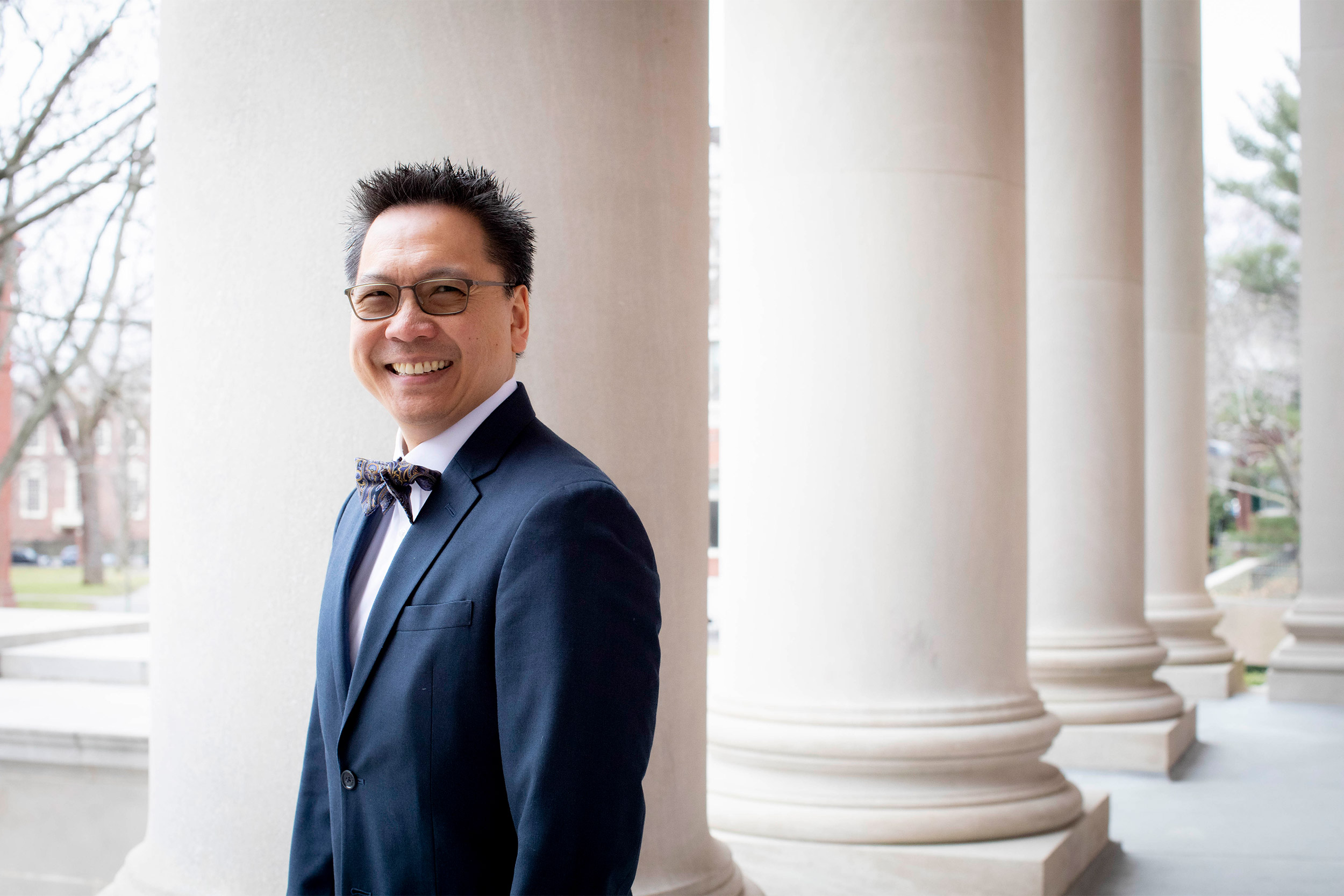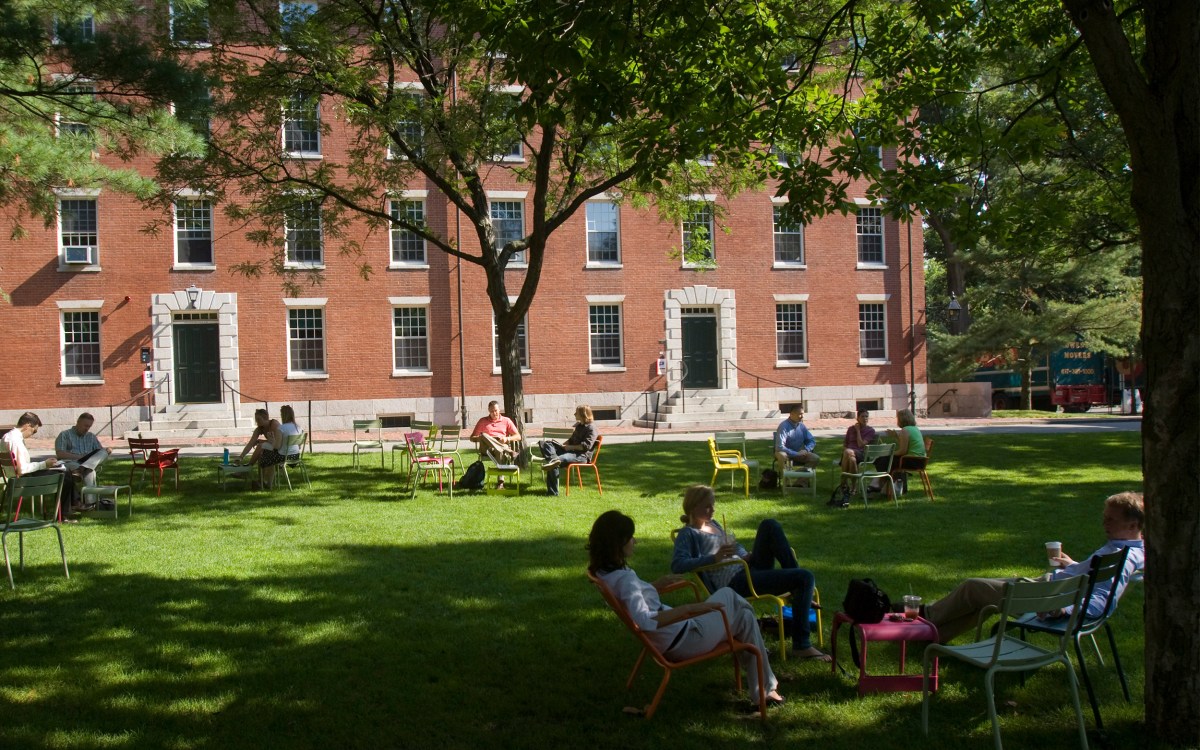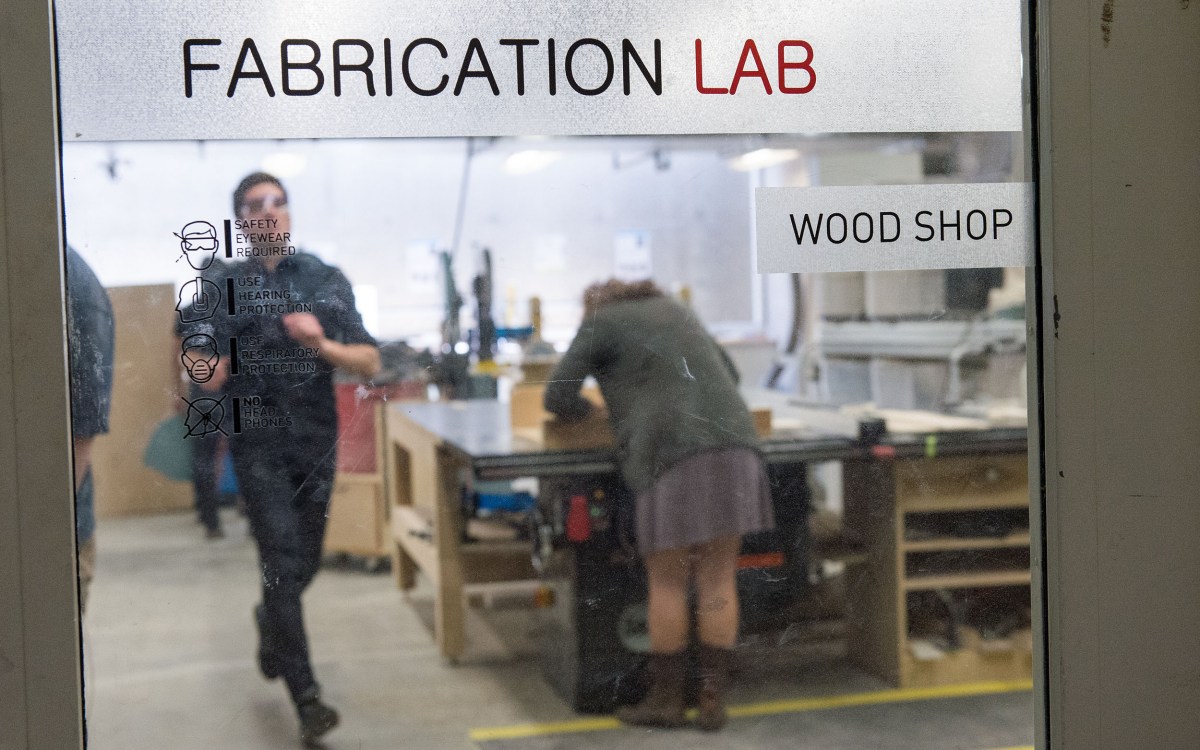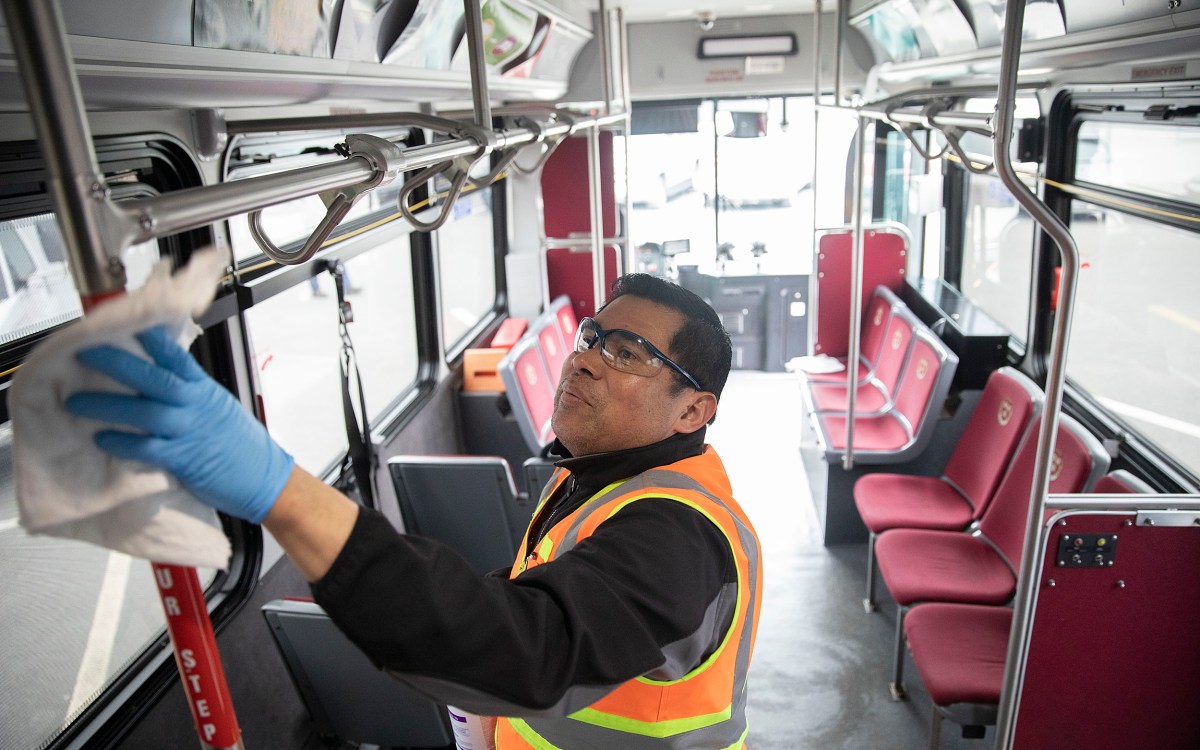
“In late January we began having daily huddles of our internal outbreak response team to ensure that we were all informed about the quickly evolving science,” said Giang Nguyen, executive director of Harvard University Health Services.
Rose Lincoln/Harvard file photo
By phone and online, the care continues
Health Services director Giang Nguyen talks about adding remote services and new resources for Harvard community
When it first became known that a novel coronavirus was spreading through Wuhan, China, Harvard University Health Services (HUHS) began preparing for its possible arrival. Since then, HUHS has been working to implement new protocols to serve the Harvard community, even as the majority of students, faculty, and staff left campus.
The Gazette spoke with HUHS Executive Director Giang Nguyen about new safety measures, including a shift to remote care by telephone and Zoom-based clinical visits. He also shared a wealth of new resources designed to inform the community about the latest developments.
Q&A
Giang Nguyen
GAZETTE: Your office first communicated with the Harvard community about the coronavirus in late January, before it was evident that COVID-19 would make such an impact worldwide. Would you give us a sense of what your early preparations looked like?
NGUYEN: Early on, as the threat of the virus was starting to be reported elsewhere in the world, HUHS began preparations, knowing that it was likely to affect our community at some point. So, as you mentioned, in late January we began having daily huddles of our internal outbreak response team to ensure that we were all informed about the quickly evolving science, and that we were also on the same page in terms of how we would respond should it arrive in our surrounding communities and on campus. Shortly thereafter, we started meeting on a daily basis with the University’s outbreak response team as well, with the support of Executive Vice President Katie Lapp.
We also formed a medical expert advisory group around the same time that included individuals with international expertise in epidemiology, virology, public health, and medicine. And they have been instrumental in guiding the policy and procedural decisions we’ve made at HUHS with regard to COVID-19, as well as the decisions that have been made by the University more broadly. I am particularly glad that we de-densified the campus when we did, and the University benefited tremendously from the input of our medical expert advisory group. Provost Alan Garber has also been very engaged from the beginning, and his expertise as a physician has helped tremendously.
We’ve been preparing our clinical staff over the past several months by making sure that all are familiar with the proper protocols for protecting themselves, as well as for recognizing patients who might be at risk for the coronavirus, and for collecting specimens from patients under investigation for COVID-19. These activities have been guided by the Centers for Disease Control and Prevention (CDC), the World Health Organization (WHO), and the Massachusetts Department of Public Health.
What has been unusual about this particular epidemic is that many of these recommendations have changed rapidly over a short period of time. As a result, the things that HUHS did in response had to evolve quickly. Many of our responses have also been influenced not only by the medical and public health knowledge at the time, but also by the degree to which resources were available. For example, as readers undoubtedly know, testing is still quite limited in the region and in America overall, and as a result we have to follow very specific guidelines from the Department of Public Health about whom to prioritize and when to test.
GAZETTE: Do you have the ability to test at HUHS?
NGUYEN: We have the ability to collect the specimens, and these specimens are sent to external laboratories for analysis. The type of testing that is done for COVID-19 requires a laboratory that is different from one in a standard ambulatory health center such as ours.
“While clinical care can’t shift entirely to a remote work protocol, we have been able to significantly limit the degree to which patients actually need to come into our office.”
GAZETTE: The University has undergone a dramatic shift to virtual learning over the past several weeks. Amid this transition, how has HUHS adapted to provide care as the Harvard community moved to remote study and work?
NGUYEN: While clinical care can’t shift entirely to a remote work protocol, we have been able to significantly limit the degree to which patients actually need to come into our office. We’ve established telephone and video visits through Zoom, and we’ve found that the majority of clinical encounters that we’ve had don’t require a patient setting foot into our space, especially if we can visualize them through Zoom.
The reality is, all visits to HUHS could potentially begin with a remote visit, with the exception of something where a person would be calling an ambulance — if a person has crushing chest pain and is unable to breathe, for example. But if it is something that is more of a moderate concern, much of that initial evaluation can be done remotely. When I’m looking at an individual through a video screen, I can see their respiratory effort, and I can observe their overall neurological status because I can see the way they are moving in front of me, I can see how quickly they’re breathing, I can observe whether they are pale or flushed, and I can see how their eyes are moving. I can also observe their emotional affect. All of these things can help guide my decision-making. Of course, there are some things that cannot be done from afar. I cannot press on your liver from across the screen, but if that ends up becoming a necessity based on what I’m seeing, and from what I hear the patient saying, then I might ask a patient to come into our office.
Even then, the time on our campus is limited, thanks to the fact that much of the information I need for an in-person consultation is already collected through this remote visit. In some cases, a patient might only need to come in to provide a urine sample or get an X-ray. So, we don’t need to have extended interactions when patients come in, and, in the context of COVID-19, if we can keep an in-person visit as short as possible, that helps everyone.
GAZETTE: What kinds of precautions are in place for patients who do need to come into the office, and for the medical professionals who provide their care?
NGUYEN: We recognize that health care workers are at an extraordinarily increased risk for infection, since they are at the front lines working with patients who may be infected with COVID-19. We have put in place a number of protocols to help protect our staff, and at the same time our patients.
We now require masks for anyone who is present within our facilities. This means any clinical and nonclinical staff who are in the office, as well as all patients or visitors. This includes all individuals who are coming in for appointments, or coming into the pharmacy to pick up prescriptions, or coming into the lab for blood tests, or to the radiology suite for X-rays. We also check everyone for fever upon entry, we advise everyone to maintain a six-foot distance from other people, and we limit elevator use to one patient at a time. By doing this, even for those people who don’t have any active symptoms, we are reducing the chance that any one person who might unknowingly be infected could spread that infection to other people.
More like this
We are also rotating our staff through the office so that only a small percentage are present at HUHS at any given time. That reduces the amount of time that any one staff member spends physically present in our office. The rest of the time they are providing remote care. It also reduces the staff density in our office.
GAZETTE: How have you managed the transition to remote care?
NGUYEN: The transition to video visits is actually something we had started preparing before COVID-19. Once the requirement for physical distancing became the norm for our region, we realized that we needed to move forward with that project at a much faster pace. I have to give a tremendous amount of thanks to our information technology team and our overall COVID-19 response team which has worked so hard to prepare our staff for the transition to telemedicine.
This was not an easy lift, and I have been so impressed by the work they’ve done to make this happen and the flexibility my staff and our patients have shown throughout this process. Our patients have been incredibly gracious and thankful that HUHS continues to provide care for them, even at a distance.
GAZETTE: What platforms does HUHS use for providing remote care, and how does HUHS ensure patient confidentiality?
NGUYEN: We use Zoom for remote visits, but what’s different for our version of Zoom, from what students are familiar with in the classroom, is that when a patient receives an invitation for an appointment with HUHS, that Zoom encounter has additional security features that a classroom encounter does not have. Our business agreement with Zoom provides a Health Insurance Portability and Accountability Act (HIPAA)-compliant version of the platform.
What does this mean in practice? The experience of a patient doesn’t feel that much different from a student in a classroom, except that they are going to be the only other person in the encounter as opposed to a classroom with 300 people. Our security features mean that sessions cannot be recorded and posted online, and each appointment has a unique link provided to the patient that protects against “Zoombombing.” There are additional security features that are largely invisible from the user standpoint. We have been very pleased with our experience with Zoom, and we’re very comfortable with the added security features it allows us.
GAZETTE: Have you noticed that HUHS continues to serve a similar clientele since its move to telemedicine?
NGUYEN: We have continued to care for a broad range of patients, including students, faculty, staff, and retirees. This hasn’t changed. Counseling and Mental Health Services (CAMHS), which provides care exclusively to students, is very active, and has been providing remote visits to students all over the country and internationally as needed. CAMHS will soon be resuming group therapy as well, which is another valuable resource for many of our students. The HUHS Behavioral Health Department, which provides counseling and psychiatric services to faculty, staff, and retirees, is keeping the same schedule of patients that they normally keep when we are operating at full scale, with the difference that these are now remote visits.
From the medical side, we have also seen a broad range of patients, students and nonstudents, and we’ve seen patients of all age ranges as well. I just heard about one of our clinicians who provided a video visit to a patient in their 80s, and they told me that it went very well. The clinician explained how helpful it was to be able to see the patient on the video screen and to incorporate that into the assessment, and how reassuring it was for the patient to be able to see the physician as well.
I also want to point out that the Center for Wellness and Health Promotion has been offering online meditation and yoga sessions that have been hosted through Zoom, and that the Office of Sexual Assault Prevention & Response has continued to offer remote events to educate the community, as well as one-on-one direct support to students through Zoom. The Office of Alcohol & Other Drug Services also continues to provide remote one-on-one services to our students.
GAZETTE: What is the best point of contact for individuals who need to access HUHS services?
NGUYEN: Patients seeking an appointment can reach out to HUHS through our secure online patient portal, or by calling us at 617-495-5711. Due to the safety and physical-distancing issues we talked about before, we discourage patients from walking in for appointments unless they have been advised to do so. If people in the Harvard community want to know more about COVID-19, or if they have questions about what new information is available about the novel coronavirus, since that is changing rapidly, I would recommend that they first start with the Harvard coronavirus website. We are frequently updating that site with new content as the science evolves. The Health and Wellbeing section is a great resource, and HUHS updates this when new information arises. We’ve also included information about how to maintain emotional wellbeing during these stressful and uncertain times.
We’ve put together a guidance document on that page that can help individuals understand if they should be self-isolating or quarantining based on their exposures. This has been particularly useful, and I’ve heard from other universities all over the country asking to use that document themselves. If folks have reviewed all of these materials and still have questions, they can reach out to our email address, healthservices@huhs.harvard.edu, where we can provide answers to nonurgent questions. This is also the address for Harvard affiliates to email if they have tested positive for COVID-19 somewhere outside of HUHS; this allows us to assess the impact on Harvard’s community. We are also available by phone, 24-7, for those who have medically urgent questions that need a response. For example, if someone is experiencing certain symptoms and needs to know whether they should go to an emergency room right now, or whether they should they come in to urgent care, these questions are worth a conversation with us, and our team is available for that.
GAZETTE: Can people be in touch to donate resources or additional supports, as well?
NGUYEN: Harvard has been blessed with an extraordinarily generous community of alumni and donors, and HUHS has received many donations of personal protective equipment (PPE), including masks and respirators. We do not need any additional PPE right now. But while some of these materials are not necessarily needed within HUHS, they might be usable within a critical-care hospital setting. To this end, we have been able to work with our campus partners to share extra supplies with local hospitals. We also encourage people to visit a webpage we’ve built devoted to donations of PPE and other critical supplies. It has been so heartwarming to see the response from members of the worldwide Harvard community who have made donations to us, and we are grateful.
This interview has been edited for length and clarity.








